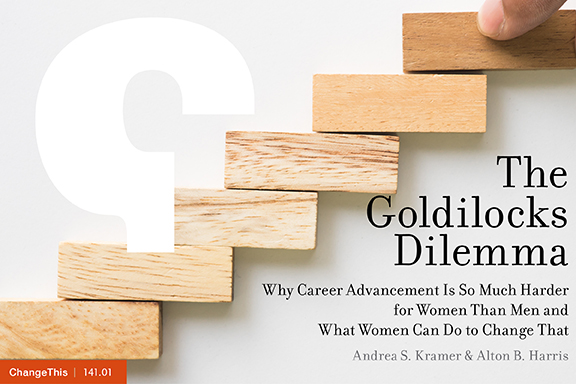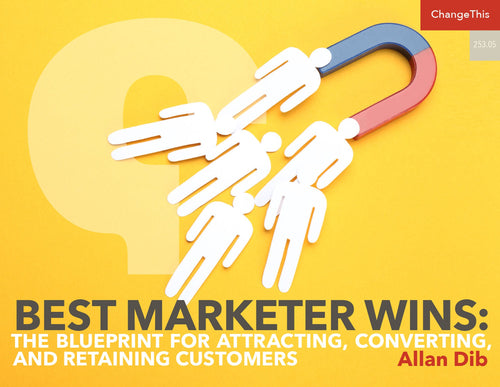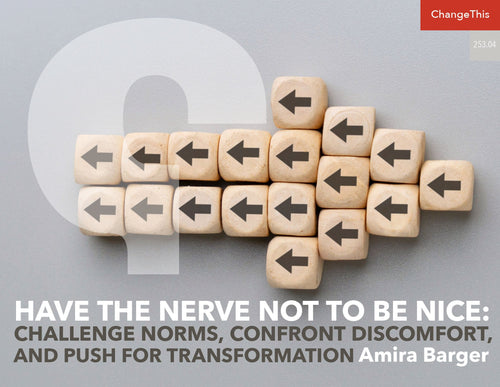The Goldilocks Dilemma: Why Career Advancement Is So Much Harder for Women Than Men and What Women Can Do to Change That
America’s workplaces, even in our best-intentioned organizations, are riddled with bias against women leaders.
As a result, women seeking to advance in careers—particularly careers in traditionally male fields—face both negative and agentic biases. Negative bias is the result of the traditional feminine stereotype that a woman is or should be “communal,” that is, warm, caring, and gentle. A woman who conforms to the communal stereotype at work is likely to be seen as pleasant, but not suited for jobs calling for competence, competitiveness, and authority. She is also likely to be seen as less talented, less suited for challenging assignments, and less worthwhile to mentor than a man.
On the other side of the “women are not as good as men” coin, a woman who violates traditional female stereotypes and behaves with authority, competence, and independence is likely to be seen as aggressive, abrasive, and bossy. This perception is what we call agentic bias, and we will elaborate on its nature and consequences in a moment.
The intersection of negative and agentic biases creates a double bind we call the “Goldilocks Dilemma.” Women who are nice, pleasant, and supportive are unlikely to be seen as leaders. Women who act with strength and authority, however, are likely to be seen as socially insensitive, unpleasant, and unlikable. Because of this double bind, women are often thought to be too hot or too cold, too soft or too hard, too nice or too abrasive.
Unquestionably, all employers, whether they are governmental, private, or not-for-profit, should do much more to reform their workplaces so that women are evaluated, compensated, and promoted on a basis comparable to men. But waiting for these reforms is unacceptable for a woman who wants to move up now.
This manifesto is about how a woman can move up in today’s gender-biased workplaces. We present a set of communication skills, what we collectively call “attuned gender communication,” that women can use to be seen as neither too hot nor too cold but “just right.” Before addressing those specific communication skills, we want to first explore in more depth the nature and operation of the negative and agentic biases. With that information in hand, we will then discuss how they work together to create the Goldilocks Dilemma, and, finally, we will turn to attuned gender communication. We will show how a woman can use this sort of communication to be seen as a person with great organizational value and career potential without running afoul of the Goldilocks Dilemma.
Negative Bias
The enormous disparity in women’s and men’s career achievements is a striking testament to how much harder it is for women to advance in their careers. This career disparity is frequently believed to be the result of some innate difference between women and men. People tend to think women are (or should be) communal, while believing men are (or should be) agentic. As a result of these stereotypes, women are expected to be gentle caregivers, and men are expected to be aggressive providers. If such views accurately reflected reality, the gendered disparities in women’s and men’s career achievements would make perfect sense. If women are cooperative and warm but not ambitious and decisive, if they are friendly and kind but lack competence and leadership ability, and if they are caring and compassionate but not committed or competitive, then it would make perfect sense that women earn less than men, reach the C-suite, equity partnership, and academic tenure less often than men, drop out of high-potential careers at a higher rate than men, and spend more time taking care of children than men.
The problem with the “women and men are just different” view is that there is no empirical evidence that it is true, much less that it is the cause of the persistent gap in women’s and men’s career achievements. Indeed, there is more variation in personality, talent, and ambition among women than there is between women as a group and men as a group.
Women earn less, advance slower, and achieve much less over the course of their careers than men. This is not because they are different, but because too many career gatekeepers don’t believe that women are able to succeed in high-pressure and high-status positions. The real culprit behind women’s and men’s disparate career achievements is the bias fostered by the pervasive and persistent workplace stereotypes about women’s and men’s abilities, potential, and characteristics.
If a woman is assumed to have communal characteristics simply because she is a woman, she is unlikely to be offered significant responsibilities, project leadership, or high-stakes negotiation opportunities—“masculine” tasks that require forceful, competent, and competitive behavior. Instead, when a woman is assumed to be communal, she is likely to be tracked into staff, personnel, or assistant positions, which are “female” jobs that require interpersonal sensitivity, cooperation, and warmth.
A particularly troubling example of gender-based career tracking was revealed by a 2012 study of the attitudes of science professors about women’s potentials as future scientists. Researchers asked biology, chemistry, and physics professors from across the country to evaluate an undergraduate science student for a position as a laboratory manager. All of the professors received exactly the same materials about the applicant; but half were told the applicant was a woman, while the other half were told the applicant was a man. The professors were asked to rate the applicant’s competence and hireability, suggest an appropriate starting salary, and indicate the amount of mentoring time they would be willing to offer the applicant. Both the female and male professors consistently judged the applicant as less competent and less qualified when they thought they were evaluating a woman. Moreover, the professors almost uniformly offered “female” applicants a lower salary and less career mentoring than they offered to “male” applicants. Because of this sort of negative gender bias, women are often not even given the chance to demonstrate their ability to actually perform a job, assignment, or responsibility that has agentic, rather than communal, associations.
It is tempting to think that negative gender bias will lose much of its discriminatory force when the current crop of business, professional, academic, and scientific leaders retire and a younger, more open-minded group replaces them. Unfortunately, a recent survey makes clear that the ascendance of the millennial generation is not likely to expand women’s career opportunities. The survey found that older survey participants were comfortable seeing women in traditionally male roles. Men between the ages of 18 and 34, however, were the most hesitant about women in leadership roles. Less than half of them were comfortable with women as Fortune 500 executives, president of the United States, U.S. senators, or engineers. Given these findings, it would be a serious mistake to assume negative gender bias will vanish as millennials sweep to power.
Agentic Bias
A woman who conforms to traditional female stereotypes will probably be viewed as pleasant and likable, but not as sufficiently competent or competitive to be a leader. This is because leadership stereotypes are starkly inconsistent with those associated with a woman. Yet, a woman who violates traditional female stereotypes and displays agentic characteristics associated with a leader—forcefully advocating a point of view, single-mindedly pursuing a competitive objective, or fiercely committing to performance excellence—is likely to experience a backlash. She is likely to be regarded as “bitter, quarrelsome, selfish, deceitful, devious, and unlikable.”
The case of Lt. Colonel Kate Germano provides a particularly striking illustration of the negative reactions women face when they behave agentically. In 2014, Germano was appointed as commander of an all-female Marine battalion at Parris Island. At the time of Germano’s appointment, women Marines trained separately from their male colleagues and were held to lower performance standards than the men, even on tasks not involving physical strength. In her one-year tenure as commander, Germano ended many of the Marines’ separate training protocols and stopped affording women special “privileges,” such as chairs after long hikes. Under Germano’s command, the women’s performance scores improved dramatically.
Nevertheless, Germano had to fight with Marine Corps brass every step of the way. In May 2015, she filed a complaint charging her supervisors with undermining her efforts to increase the performance of the female Marines under her command. Germano’s complaint triggered an investigation, and she was relieved of her command one month later, on the grounds that “her toxic leadership style … created a hostile, repressive, unprofessional command climate.”
Germano’s supporters claim she was “firm but fair,” and argue that her leadership style would never have been criticized if she had been a man. Her detractors assert she was authoritarian and abusive, “mistreating” her female recruits. We don’t know enough to pass final judgment on Germano’s conduct, but it is clear she was subjected to severe agentic bias—even if that was not ultimately why she was relieved of her command. Germano was publicly criticized as “too aggressive,” “too blunt,” and “too direct” and she was rebuked for suggesting that the Marines’ performance standards for women “are not good enough.” There is no doubt that Germano used strongly agentic behavior to achieve her objective. We wonder, however, whether anyone will be able to help women Marines earn the respect they deserve if they behave in a different way.
Admirably, Germano has not given up the fight. In January of 2016, she wrote a thoughtful article in the Military Times arguing if the Marine Corps is to be successful in fully integrating its women and preparing them to perform jobs comparable to the men, women and men must train together. As Germano put it, “Segregation imprints the thought within male recruits that females are ‘the other’ and perpetuates the false position that they are less mentally and physically competent.” And on March 30th of this year, Germano wrote that the Marine Corps’ refusal to change its existing recruiting practices and segregated recruit training for women, “only serves to reinforce the sexism and gender bias so prevalent in the Marine Corps today.”
The Goldilocks Dilemma
Women encounter negative bias by conforming to traditional female stereotypes and encounter agentic bias by violating those stereotypes and behaving with authority and strength. Because of negative bias, career advancement is impossible if a woman consistently behaves in a communal way. But, because of agentic bias, if she consistently behaves in an agentic way, it may be impossible for her to achieve career success and to be liked. The Goldilocks Dilemma places women between a rock and a hard place. As a result, women often choose to be less ambitious in order to be more likeable.
Harvard Business School (HBS) found in 2011 that its women prepared more but participated less in class than its men; at graduation, the women received significantly fewer academic honors than did the men; and after graduation, the women reported their HBS experiences as far less positive than did the men.
In seeking an explanation for why women and men responded to HBS in such different ways, Harvard found two principal factors adversely affected women students. First, there was an obvious clannishness on the part of male professors and male students that made the women feel isolated. HBS took immediate steps to correct this problem.
But, Harvard also uncovered a far subtler and more intractable problem. It found that the women were “self-editing in the classroom to manage their out-of-classroom image[s].” The women were found to be less comfortable participating in the rough and tumble of class discussions because they believed they would be penalized for violating traditional gender stereotypes. The women were trying to appear less forceful in the classroom to appear more likable outside of class.
Thus, extraordinarily talented women studying at one of the most distinguished business schools in the world were holding themselves back because they were worried that they would not be socially accepted if they competed “too hard.” These women were trying to succeed a little less in order to be liked a little more. This is a disastrous strategy for escaping the Goldilocks Dilemma. It masks a woman’s true abilities, while failing to give full play to the qualities that make her likable.
The Goldilocks Dilemma also creates a particularly crushing problem for women with children. On the one hand, it is assumed that mothers need to be available to their children at all times, and, therefore, mothers are viewed as less committed to their careers than women without children or men (without regard to whether they are fathers). If, on the other hand, mothers demonstrate they are fully committed to their careers, they are viewed as bad mothers.
Career gatekeepers typically believe that mothers are overly concerned with work/life balance, poorly matched to the demands of their jobs, and less attractive candidates for promotion than women without children. In addition, mothers who show a strong commitment to their careers are presumed to be less warm, less nice, less friendly, less likable, and more hostile than women without children. Because of the Goldilocks Dilemma, mothers are less likely to be hired and are more likely to be offered lower salaries than childless women—despite being equally competent. One study found that when mothers were compared to women without children, mothers were 79 percent less likely to be hired, 100 percent less likely to be promoted, offered an average of $11,000 less in salary, and held to higher performance and punctuality standards. Consequently, mothers must perform the high-wire juggling act of raising children and managing a career while finding a way to overcome the Goldilocks Dilemma.
Attuned Gender Communication
There is a clear way forward for a woman to achieve career success despite the Goldilocks Dilemma. The key is for a woman to learn to exhibit both communal and agentic characteristics in the right measure at the right times. A woman who can do this can manage the impressions others have of her so that she is neither too soft nor too hard but just right. Perhaps the best way to understand the basic insight underlying attuned gender communication is to look at yet another recent study.
Researchers tracked 132 female and male MBA graduates over an eight-year period. Some (but by no means all) of the women in this group were highly self-aware and comfortable behaving communally, agentically, or employing both sorts of behaviors simultaneously, depending on the impression they wanted to make to accomplish their objective in a given situation. Women with the ability to consciously manage their behavioral style received 1.5 times as many promotions as agentic men, 1.5 times as many promotions as communal women, 2 times as many promotions as communal men, and 3 times as many promotions as agentic women.
The most successful women in this study understood that their behavior directly controlled the impressions people had of them. These women were highly sensitive to the reactions other people had to how they presented themselves. They were aware of the effect of their verbal and nonverbal behavior. They were willing to change their presentation style if the reactions they were getting and the impressions they were making were not the ones they wanted. Highly aware female MBAs understood that their career success was directly influenced by their style: their presence, attitudes, posture, body movements, facial expressions, dress, voice patterns, responses, and reactions.
Attuned gender communication, thus, is the conscious control of what you are communicating to the people with whom you are dealing as a result of the totality of your verbal and nonverbal behavior. Many factors will influence when, why, and how you manage your communications, but two factors are key to your doing it successfully. The first is a high degree of self-awareness: awareness of your feelings, reactions, and attitudes, your verbal and nonverbal behavior, and the image—impression, sense, feeling—you are presenting of your abilities, credibility, and potential. The second is your capacity to change that image by changing how you present yourself, including changing your presence, manner, and confidence. A woman using attuned gender communication is capable of dialing down agentic behavior and dialing up communal behavior or the reverse, depending on both context and objective. To get a better sense of how a woman can do this, we want to examine particular behavior patterns.
First, here are a few nonverbal behaviors you should avoid because they are seen as unredeemably communal and, therefore, likely to trigger negative bias:
- Don’t tilt your head, act flirty or coy, smile excessively or at inappropriate moments, nod excessively, or raise your voice at the end of a declarative sentence.
- When you have a point to make, don’t undercut the strength and importance of your comment by beginning with phrases such as, “I may be off base here but …”; “I don’t know if this is helpful but …”; “Maybe I’m wrong about this but …”
- Unless you have actually done something deserving of an apology, don’t say, “I’m sorry.” This phrase may be ideal to express sympathy or strengthen friendships in a social context, but in the workplace the phrase undercuts your gravitas and suggests you are somehow at fault.
- Avoid behavior that suggests you have low power, little self-confidence, or poor task competence.
- Avoid the use of a soft, hard-to-hear tone of voice, frequent repetitions and false starts, tentative pauses in a presentation, and the use of filler words such as “hum,” “perhaps,” or “uh-huh.”
- Avoid slumped body posture, nervous hand gestures, averted eyes, and frequent touching of your hair, jewelry, or clothes.
So much for negative behavior. Let’s look now at a few ways to project competence and confidence, while also coming across as warm, inclusive, and likable:
- When you are at a conference table, spread out. Don’t be sloppy or obviously hog space, but use as much space as the most important man does.
- Sit tall, have your arms on the table in front of you, and lean forward slightly when you speak.
- Gesture inclusively, maintain a warm and pleasant facial expression, and pay obvious attention to others. Likewise, when you are standing, stand tall with a relaxed and open body posture. Directly face the person or people you are addressing.
- Don’t cross your ankles or shift your weight from one foot to the other while standing.
- Use your full height.
- Gesture away from your body with calm, inclusive gestures, and don’t cross your arms over your chest.
- Maintain moderate eye contact with the people with whom you are interacting.
- Your facial expression should be warm and pleasant.
- Hold your head straight with your chin slightly up.
- Speak with authority; use clear, direct and unambiguous statements.
- Humor can be a great tension reliever. Avoid self-deprecating humor, but a humorous response to a sexist comment or biased observation is often more effective than apparent indignation.
- Always dress and groom purposefully in light of what “look” you believe will be most effective to accomplish your objective. This will be different in different contexts, but whatever the context, you want your appearance to convey self-confidence, competence, seriousness, and warmth.
These few suggestions should make clear that attuned gender communication involves combining agentic and communal behavior to be seen as competent and confident, but not cold or unpleasantly aggressive. Attuned gender communication does not require you to mute your forcefulness or downplay your ambition or competitive instinct. It does, however, require you to recognize that the forceful agentic self-assertion that might work for a man is not going to work for a woman. You should never be hesitant to speak up, assert a point of view, or give instructions, but you need to do so while projecting a sense of pleasant engagement, an openness to different points of view, and a keen social sensitivity. Men can be jerks and still move into leadership positions; women who are seen as jerks or worse are unlikely to ever do so.
Emotion in the office is another minefield for women, so let’s think about how you can effectively use attuned gender communication for career advancement despite the stereotypes about women being emotional. If you show emotion, you will likely confirm the gender stereotype of an irrational and out of control female. You must learn to express your feelings in ways that allow you to come off as competent, intentional, and in control, not as irrational, excitable, or unstable.
There are six emotions that are particularly problematic for women in the workplace: anger, frustration, resentment, distress, sadness, and contempt. The first five of these—anger, frustration, resentment, distress, and sadness—are fraught with problems in their own right, but they are particularly dangerous emotions for a woman because they can trigger crying, and crying in the office is almost always a bad idea. It is likely to reflect poorly on your competence and leadership ability. Such a display of emotion implies you are weak, unprofessional, and lack control and confidence.
For women to be recognized in their careers for their ability and leadership capability they need to be able to utilize the positive aspects of both communal and agentic behavior. When negative bias is a distinct possibility, women need to play up their agentic characteristics to dispel the assumption that they lack competence, confidence, or a competitive appetite.
Likewise, when agentic bias appears to be a distinct possibility, women can temper their forceful behavior with a healthy dose of warmth and inclusiveness. The trick for a woman is to pair agentic behavior that exhibits power and confidence with communal behavior that projects warmth, inclusiveness, and social sensitivity.
Attuned gender communication depends on understanding the operation of negative and agentic biases and how they create the Goldilocks Dilemma. Gender bias is alive and well in American workplaces, and it is the primary reason why career advancement is so much harder for women than it is for men. But with attuned gender communication, women can escape the Goldilocks Dilemma and advance as far and as fast in their careers as their hard work and talent will allow them.











































